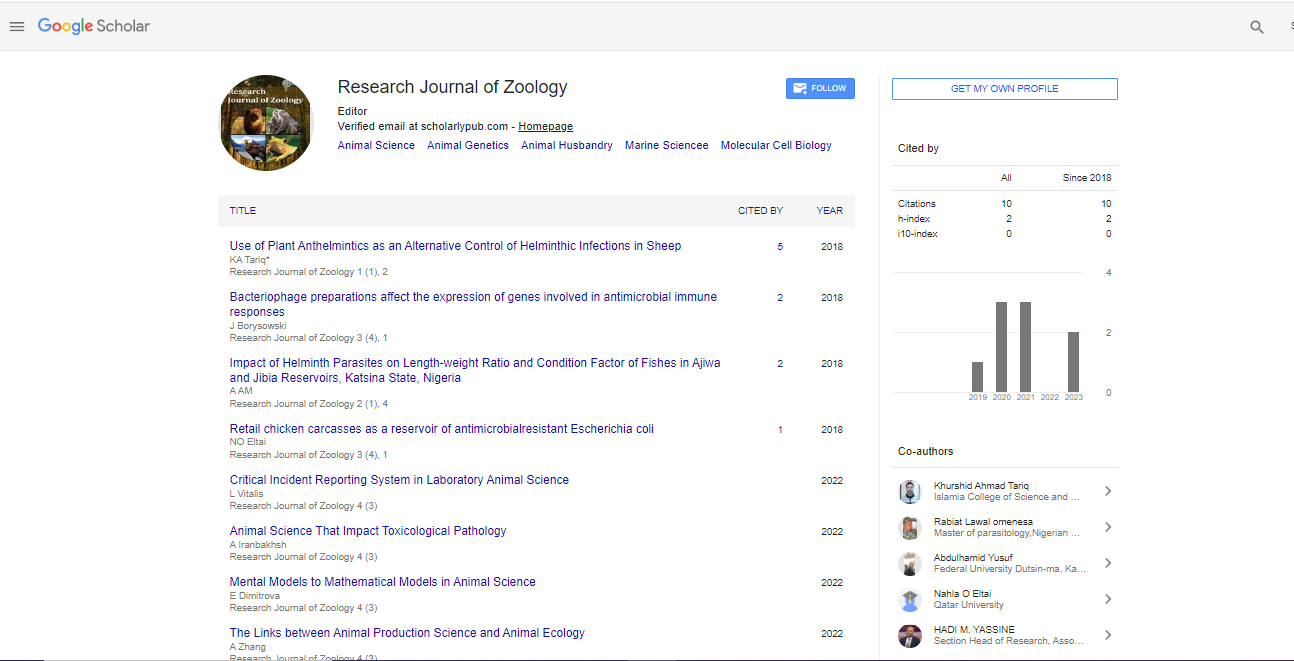Opinion Article, Res J Zool Vol: 5 Issue: 2
Fossil Conservation and Prospects in Paleozoology
Esteban Leon*
1Department of Vertebrate Paleontology, National University of La Plata, La Plata, Argentina
*Corresponding Author: Esteban Leon,
Department of Vertebrate Paleontology,
National University of La Plata, La Plata, Argentina
E-mail: leonesteban@gmail.com
Received date: 29 May, 2023, Manuscript No. RJZ-23-106989;
Editor assigned date: 31 May, 2023, PreQC No. RJZ-23-106989 (PQ);
Reviewed date: 14 June, 2023, QC No. RJZ-23-106989;
Revised date: 21 June, 2023, Manuscript No. RJZ-23-106989 (R);
Published date: 28 June, 2023, DOI: 10.4172/Rjz.1000083.
Citation: Leon E (2023) Fossil Conservation and Prospects in Paleozoology. Res J Zool 5:2.
Description
Paleozoology is a branch of paleontology that focuses on the study of ancient animals and their evolutionary history. It involves the analysis of fossilized remains and traces of animals from the Paleozoic Era, which spanned from approximately 541 million years ago to 252 million years ago. Paleozoologists play a vital role in reconstructing the diversity, morphology, behavior, and ecological interactions of prehistoric organisms, providing valuable insights into the evolution of life on Earth. Paleozoology is an interdisciplinary field that combines principles of biology, geology, and paleontology. It involves the examination of fossils, which are the remains of once-living organisms preserved in rocks. These fossils provide a unique window into the ancient past, allowing scientists to piece together the evolutionary history and ecological dynamics of ancient life forms.
The Paleozoic Era is one of the major divisions of geological time and spans a significant portion of Earth's history. It is divided into six periods: the Cambrian, Ordovician, Silurian, Devonian, Carboniferous, and Permian. Each period witnessed remarkable changes in the diversity and complexity of life on Earth, leading to the emergence of diverse animal groups. The fossil record is the accumulation of all the fossils discovered on Earth. It provides a snapshot of the evolutionary history of life and allows paleozoologists to study the past biodiversity. Fossilization is a rare process, and only a small fraction of organisms that lived in the past became fossilized. Understanding the biases and limitations of the fossil record is essential for accurate interpretations.
The transition from aquatic to terrestrial life was a pivotal event in the history of life on Earth. Early land-dwelling organisms, such as early amphibians and arthropods, played important roles in colonizing the terrestrial environment and establishing the first terrestrial ecosystems. The Paleozoic Era witnessed several mass extinction events, during which a significant percentage of Earth's species went extinct. The end-Permian mass extinction, the most severe of these events, resulted in the loss of approximately 96% of all marine species and had far-reaching consequences for the evolution of life. While the Paleozoic Era predates the appearance of modern humans, paleozoology provides a broader context for understanding the evolutionary processes that ultimately led to the emergence of Homo sapiens. By studying the early evolutionary history of vertebrates, including fish and amphibians, paleozoologists contribute to our understanding of the origins of the vertebrate lineage.
The Paleozoic Era was characterized by significant climate fluctuations, which influenced the distribution and diversity of ancient organisms. Understanding how past organisms responded to environmental changes can provide valuable insights into the potential impacts of modern climate change on today's fauna. Palezoologists' findings have far-reaching implications for other fields of Earth sciences, such as paleoclimatology, paleoecology, and stratigraphy. The study of ancient animals helps reconstruct past environments and ecosystems, enabling scientists to develop more accurate models of Earth's history. Paleozoologists face several challenges in their research. Fossilization is a rare event, and finding well-preserved fossils from specific time periods and locations can be challenging. Moreover, the interpretation of fossils requires careful consideration of taphonomy, the study of processes affecting the preservation of organisms in the fossil record.
Non-destructive imaging techniques allow researchers to study internal structures and soft tissues of fossils without damaging the precious specimens. Preserving fossil sites is important for the advancement of paleozoology. Paleontological sites are non-renewable resources that hold unique and invaluable information about past life. Proper management and conservation efforts are essential to protect these sites for future generations of scientists.
Conclusion
In conclusion, paleozoology is a captivating field that provides a glimpse into the distant past and the extraordinary diversity of ancient life. Through the study of fossils and their ecological contexts, paleozoologists contribute significantly to our understanding of the evolution and dynamics of prehistoric organisms. Their work not only enriches our knowledge of Earth's history but also provides valuable insights into the processes that have shaped life on our planet. As technology and research methods continue to advance, the future of paleozoology looks promising. Scientists will likely uncover new fossil discoveries, refine existing knowledge about ancient organisms, and continue to shed light on the fascinating evolutionary history of life on Earth.
 Spanish
Spanish  Chinese
Chinese  Russian
Russian  German
German  French
French  Japanese
Japanese  Portuguese
Portuguese  Hindi
Hindi 
